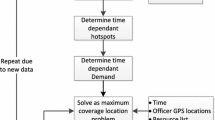Abstract
Violent crimes such as ram raids and armed robberies have a substantial impact on the physical, emotional and material wellbeing of victims. Therefore these crimes typically receive the highest priority from the police. In this paper we present prescriptive models to deploy police patrol units to improve their ability to respond timely to such crimes. These models can also help police administrators to assess the effectiveness of proposals that attempt to advance the moment when the police arrives on the scene. The models are illustrated by an application to real-life data from a Belgian police zone from which some general guidelines are derived.
Similar content being viewed by others
References
Batta R., Dolan J. and Krishnamurthy N. (1989). The maximal expected covering location problem: revisited. Transportation Science 23:277–287.
Berman O., Larson R. and Parkan C. (1987). The stochastic queue p-median problem. Transportation Science 21:207–216.
Birge J. and Pollock S. (1989). Using parallel iteration for approximate analysis of a multiple server queueing system. Operations Research 37:769–779.
Birge J. and Pollock S. (1989b). Modelling rural police patrol. Journal of the Operational Research Society 40:41–54.
Boyd S., Kim S., Vandenberghe L., Hassibi A. (2007). A tutorial on geometric programming. Optimization and Engineering 8:67–127.
Boyd P. and Vandenberghe L. (2004)Convex Optimization. Cambridge University Press, 730p.
Brandeau M. and Larson R. (1986). Extending and applying the hypercube queueing model to deploy ambulances in Boston. In: Swersey A. and Ignall E. (eds.) Delivery of Urban Services, TIMS Studies in the Management Sciences 22, Elsevier, 121–153.
Brown G., Carlyle M., Salmerón J., Wood K. (2006). Defending Critical Infrastructure. Interfaces 36:530–544.
Chelst K. (1978). An algorithm for deploying a crime directed (tactical) patrol force. Management Science 24:1314–1327.
Chelst K. and Jarvis J. (1979). Estimating the probability distribution of travel times for urban emergency service systems. Operations Research 27:199–204.
Chiang M. (2005). Geometric Programming for Communication Systems. Foundations and Trends in Communications and Information Theory 2:1–154.
Daskin M. and Haghani A. (1984). Multiple vehicle routing and dispatching to an emergency scene. Environment and Planning A 16:1349–1359.
Gass S. (1994). Public sector analysis and operations research/management science. In: Pollock S., Rothkopf M. and Barnett A. (eds.) Operations Research and the Public Sector 2, Elsevier Science B.V., 23–46.
Green L. (1984). A multiple dispatch queueing model of police patrol operations. Management Science 30:653–664.
Jarvis J. (1981). Optimal assignments in a Markovian queueing system. Computers and Operations Research 8:17–23.
Kharoufeh J. and Gautam N. (2004). Deriving Link Travel-Time Distributions via Stochastic Speed Processes. Transportation Science 38: 97–106.
Langville A. and Stewart W. (2004). The Kronecker product and stochastic automata networks. Journal of Computational and Applied Mathematics 167:429–447.
Larson R. (1974). A hypercube queueing model for facility location and redistricting in urban emergency services. Computers and Operations Research 1:67–95.
Larson R. (1975). Approximating the performance of urban emergency systems. Operations Research 13:845–868.
Serra D. and Marianov V. (2004). New Trends in Public Facility Location Modeling. UPF Economics and Business Working Paper No. 755.
Owen S. and Daskin M. (1998). Strategic facility location: A review. European Journal of Operational Research 111:423–447.
Van Oudheusden D. and Plastria F. (1978). Un modle de localisation comme application de la théorie des jeux, Annales de la Faculté des Sciences de Kinshasa, Zaïre, Sect. Math. Phys. 4:247–268.
Sacks S. and Grief S. (1994). Orlando Magic: Efficient Design of Police Patrol Districts. OR/MS Today 21:30–32.
Weisburd D. and Eck J. (2004). What Can Police Do to Reduce Crime, Disorder, and Fear? The Annals of the American Academy 593:42–65.
Author information
Authors and Affiliations
Corresponding author
Rights and permissions
About this article
Cite this article
Moonen, M., Cattrysse, D. & Van Oudheusden, D. Organising patrol deployment against violent crimes. Oper Res Int J 7, 401–417 (2007). https://doi.org/10.1007/BF03024855
Issue Date:
DOI: https://doi.org/10.1007/BF03024855




